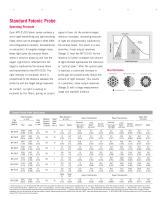
Catalog excerpts

A worldwide leader in precision measurement solutions High resolution, non-contact measurement of vibration and displacement
Open the catalog to page 1
MTI-2100 FotonicTM Sensor Unmatched Resolution and Frequency Response in Non-Contact, Fiber-Optic Measurement The MTI-2100 features advanced fiber-optic and electronic technologies for precise measurements of displacement, position and vibration. It sets new performance standards with resolution as low as 0.01 µin. (2.5 angstroms) and frequency response from direct-coupled (dc) to 500 kHz. The MTI-2100’s modular design has the flexibility to be tailored to specific requirements through the Dual-channel capability enables the user to make use of a wide range of interchangeable and custom...
Open the catalog to page 2
System Features & Advantages Single or dual probe module operation allows two simultaneous measurements Backlit LCD display shows output in volts or engineering units, indicates measurement parameters and calibration setup LED position indicator shows “at-a-glance” probe position Built-in peak-to-peak detector ideal for vibration amplitude measurements Over/under range alarms indicate outof-range conditions Range selector provides two distinct measurement 7-Position ranges for each low-pass filter probe module Auto zero selector resets display/output to zero for relative measurements...
Open the catalog to page 3
Standard Fotonic Probe Operating Principle Each MTI-2100 Fotonic probe contains a signal of zero. As the probe-to-target set of light transmitting and light receiving distance increases, increasing amounts fibers, which can be arranged in three differ- of light are proportionally captured by ent configurations (random, hemispherical the receive fibers. The result is a very or concentric). A tungsten halogen lamp sensitive, linear output response Optical Peak feeds light down the transmit fibers, distance is further increased, the amount target. Light that is reflected from the is reached, a...
Open the catalog to page 4
Reflectance Compensated Fotonic Probe probe module’s electronics use the differ- that automatically compensates for large ence between the two receive bundles to changes in reflectivity of the target being compensate for reflectivity changes and measured. This unique design makes it provide a linear response proportional possible to monitor targets over a dynamic to probe gap. This concept allows the reflectance range of 100:1, while main- taining high resolution and accuracy. where the target is translating or rotating. The probe consists of three integrated Output Voltage MTI also offers...
Open the catalog to page 5
General Specifications Power Requirements 100 to 240 Vac, 50/60 Hz. Maximum Power Dissipation: 35 W. Fuse: 1.25 A, time delay, 250 V, 5 x 20 mm. Standard Probe Specifications (MTII does not guarantee leak-proof operation) Environmental Requirements Instrument Operating Temperature: 50°F to 110°F (10°C to 43°C) non-condensing. Instrument Storage Range: 0°F to 150°F (-18°C to 65°C) non-condensing. Display Meter: graphic LCD, white on blue background, 100 Hz response, updates 3 times per second. Bar Graph: 20-element green LED (0.5 Volt step size), 10 Hz response. Displacement Measurements...
Open the catalog to page 6All MTI Instruments catalogs and technical brochures
-
ACCUMEASURE SERIES 9000
6 Pages
-
1510A
2 Pages
-
PROFORMA 300iSA
4 Pages
-
Proforma 300i
2 Pages
-
PBS-4100+
6 Pages
-
ProTrak TM 2D/3D
4 Pages
-
MICROTRAK 3
4 Pages
-
Microtrak 4 Laser Sensor
4 Pages
-
ACCUMEASURE AS-563
2 Pages
-
ACCUMEASURE AS-562
2 Pages
-
MicroStage traction
2 Pages
-
MICROTRAK? 3 TGS
4 Pages
-
PBS-4100R+
8 Pages
-
PV Series
6 Pages
-
MICROTRAK PRO - 2D
4 Pages
-
Laser Thickness Gauge System
4 Pages
-
1510A
6 Pages
-
42CA
1 Pages
-
41CA
1 Pages
-
ACCUMEASURE 500
6 Pages
-
ACCUMEASURE MICROCAP
2 Pages
-
MTI-2100 FOTONIC
6 Pages
-
OEM capacitance board
2 Pages
-
CAPACITANCE PROBES - Digital
5 Pages
-
PV 1000 Solar Inspection
6 Pages
-
Wafer Metrology System
2 Pages
-
45CA
1 Pages
-
TSC-4800A
6 Pages
-
2 Dimensional Laser Sensor
4 Pages
-
OEM capacitance board
2 Pages
Archived catalogs
-
MICROTRAK II (DISCONTINUED)
4 Pages
-
APEX SERIES
2 Pages
-
ACCUMEASURE 9000
6 Pages
-
FS6-1 RIGHT ANGLE BRACKET
1 Pages
-
Capacitance Measurement
6 Pages
-
TSC-4100R
1 Pages
-
PBS-4100 Plus
6 Pages
-
MTI- 2100 Fotonic Sensor
6 Pages






























































